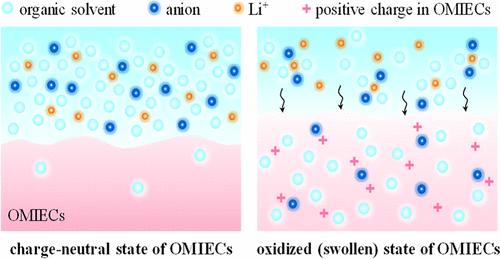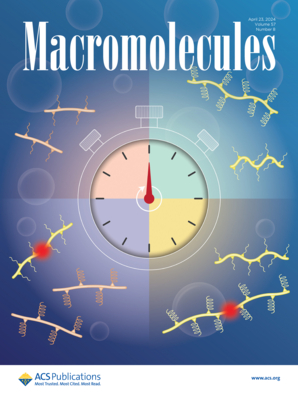Molecular Mechanism of Mechanical Breathing in Organic Mixed Ionic-Electronic Conductors
IF 5.1
1区 化学
Q1 POLYMER SCIENCE
引用次数: 0
Abstract
Mechanical breathing of organic mixed ionic-electronic conductors (OMIECs) is a structural response upon redox reactions. The breathing strain is often in the range of a few percentages to a few hundred percentages in different OMIECs operated in different chemical environments. Such mechanical activation needs to be tailored such as to be maximized in actuators and to be minimized in increasing the device reliability. We perform atomistic modeling to understand the molecular mechanism of mechanical swelling of OMIECs immersed in various electrolytes and at different oxidation states. We study poly(3,4-propylenedioxythiophene) (PProDOT) which is widely used in organic electrochromic devices as a model system and compare its swelling behavior in electrolytes of different salt concentrations, solvents, and anions. PProDOT deforms more in the electrolyte of lower salt concentration and larger anions. Mass transport of the electrolyte, especially the organic solvent, is dominant in regulating mechanical swelling of PProDOT compared to the electrostatic interactions. We examine the evolution of microstructural features and local bonding environments associated with the mixed conduction upon oxidation. We calculate the diffusion coefficients of the cation, anions, and solvents in the mixture of PProDOT and the electrolyte, which inform the swelling kinetics of PProDOT and the solvation structure in the electrolyte. The results are further validated by different self-aggregated PProDOT configurations and modeling protocols. The finding is in good agreement with the experiments and provides fundamental understanding of the molecular motifs underpinning the breathing strain in OMIECs.

有机混合离子-电子导体中机械呼吸的分子机制
有机混合离子电子导体(OMIECs)的机械呼吸是氧化还原反应的结构反应。在不同的化学环境中,不同的omiec的呼吸压力通常在几个百分比到几百个百分比之间。这种机械激活需要量身定制,例如在执行器中最大化,在增加设备可靠性时最小化。我们通过原子模型来了解omiec在不同电解质和不同氧化态下机械膨胀的分子机制。本文研究了广泛应用于有机电致变色器件的聚(3,4-丙烯二氧噻吩)(PProDOT)作为模型体系,比较了其在不同盐浓度、溶剂和阴离子电解质中的溶胀行为。PProDOT在低盐浓度和较大阴离子的电解质中更易变形。与静电相互作用相比,电解质,特别是有机溶剂的质量传递在调节PProDOT的机械膨胀中起主导作用。我们研究了与氧化混合传导相关的微观结构特征和局部键合环境的演变。我们计算了PProDOT和电解质混合物中阳离子、阴离子和溶剂的扩散系数,从而了解了PProDOT的溶胀动力学和电解质中的溶剂化结构。通过不同的自聚合PProDOT配置和建模协议进一步验证了结果。这一发现与实验结果很好地一致,并提供了对OMIECs呼吸紧张的分子基序的基本理解。
本文章由计算机程序翻译,如有差异,请以英文原文为准。
求助全文
约1分钟内获得全文
求助全文
来源期刊

Macromolecules
工程技术-高分子科学
CiteScore
9.30
自引率
16.40%
发文量
942
审稿时长
2 months
期刊介绍:
Macromolecules publishes original, fundamental, and impactful research on all aspects of polymer science. Topics of interest include synthesis (e.g., controlled polymerizations, polymerization catalysis, post polymerization modification, new monomer structures and polymer architectures, and polymerization mechanisms/kinetics analysis); phase behavior, thermodynamics, dynamic, and ordering/disordering phenomena (e.g., self-assembly, gelation, crystallization, solution/melt/solid-state characteristics); structure and properties (e.g., mechanical and rheological properties, surface/interfacial characteristics, electronic and transport properties); new state of the art characterization (e.g., spectroscopy, scattering, microscopy, rheology), simulation (e.g., Monte Carlo, molecular dynamics, multi-scale/coarse-grained modeling), and theoretical methods. Renewable/sustainable polymers, polymer networks, responsive polymers, electro-, magneto- and opto-active macromolecules, inorganic polymers, charge-transporting polymers (ion-containing, semiconducting, and conducting), nanostructured polymers, and polymer composites are also of interest. Typical papers published in Macromolecules showcase important and innovative concepts, experimental methods/observations, and theoretical/computational approaches that demonstrate a fundamental advance in the understanding of polymers.
 求助内容:
求助内容: 应助结果提醒方式:
应助结果提醒方式:


